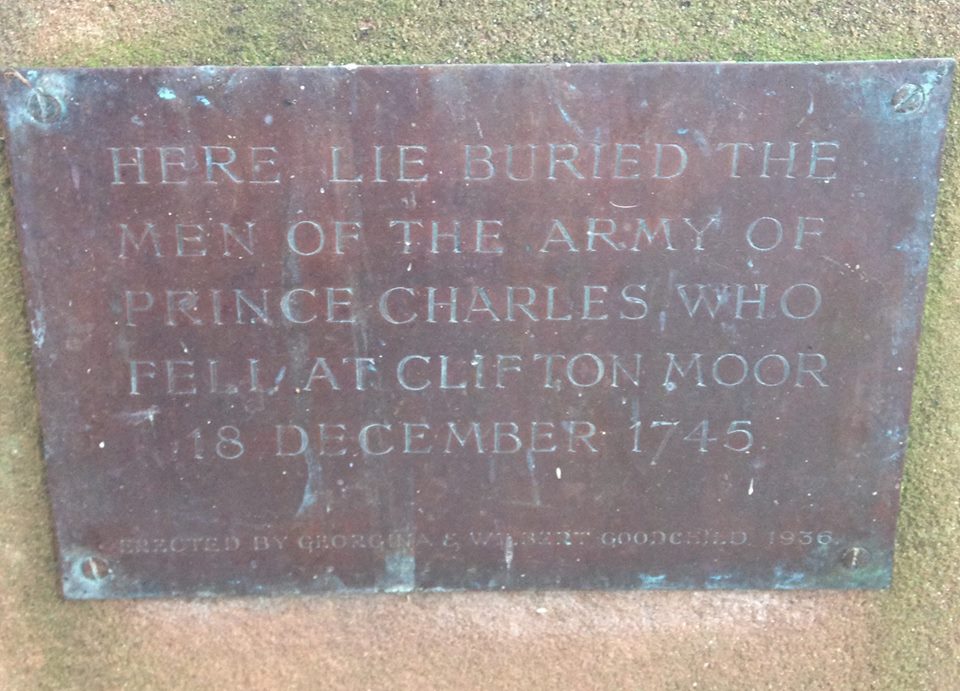History of the Stewarts | Battles and Historic Events
If you are a Stewart Society Member please login above to view all of the items in this section. If you want general information on how to research your ancestors and some helpful links - please look in background information.
If you have a specific question you can contact our archivist.

Commerative marker at Clifton Moor
On the 18th a body of between 200 and 300 horse of the Duke of Cumberland´s forces, formed in front of the rear-guard, to make a stand. The Glengarry regiment, with Lord George Murray at its head, was in the rear of the column. On reaching Clifton, he then, at the head of the Glengarry regiment and some horse, examined the land in the hope of attacking the government cavalry. However, although he saw several of them, he only succeeded in taking two prisoners. One of whom was one of Cumberland´s mounted footmen who told Lord George that the Duke of Cumberland himself, with a body of 4,000 horse, was about a mile behind him. This prisoner was sent back to Cumberland by the Prince later.
Clifton was a good defensible place to stop, Lord George intended to remain there to wait for the government attack therefore he sent Colonel Roy Stuart with the two prisoners to Penrith, to inform Prince Charles of duke´s approach, and that he would remain at Clifton until further orders. In the event of the prince approving of his intention of making a stand at Preston, his lordship requested that 1,000 men might be sent him from Penrith. In reversal of their normal roles, the Prince was against making a full battle whilst Lord George thought that Clifton provided him with an excellent defensive position was keen to fight there.
Within the enclosures beside the road he posted the Glengarry men, and within those to their left he placed the Stewarts of Appin and the Macphersons. On the side of the road, and close to the village of Clifton, he placed Colonel Roy Stuart´s regiment. As some ditches at the foot stretched further towards the moor on the right than on the left, and as that part was also covered by Lord Lonsdale´s other enclosures, the men on the right could not be attacked easily. This advantage meant that they could flank the enemy when they attacked the left.
Lord George had about 1000 men, Cumberland initially put 250 men into a dismounted assault and at 5pm Lord George ordered the Appin regiment and the Macphersons to adjust their position which then brought them into direct contact with their enemy. The dismounted men as the Appins advanced began to run away. The Jacobites and the government troops engaged in the dark in the village but after about 30 minutes of fighting Lord George directed his troops along the road to Penrith to rejoin the army.
Cumberland occupied Clifton at about 6pm and launched one last attack on the Jacobites, who had for the most part withdrawn by that time.
Casualties on both sides were light. Ten dragoons are listed in the parish register as having been killed, and they are probably the men who lie in the communal grave at Clifton. Near the churchyard gate is a stone commemorating the event. However there were estimates of more deaths on the government side - perhaps 30 or 40 and around 5 Jacobites were killed also. However of more significance was that Cumberland had become unsure of the strength of the Jacobites and therefore did not dare commit himself to another fight between Clifton and Penrith.
Two Jacobite prisoners were taken - Thomas Ogden of the Manchester and George Hamilton of Redhouse. Hamilton was executed on 1 October 1746.
Reference: The '45 Christopher Duffy

